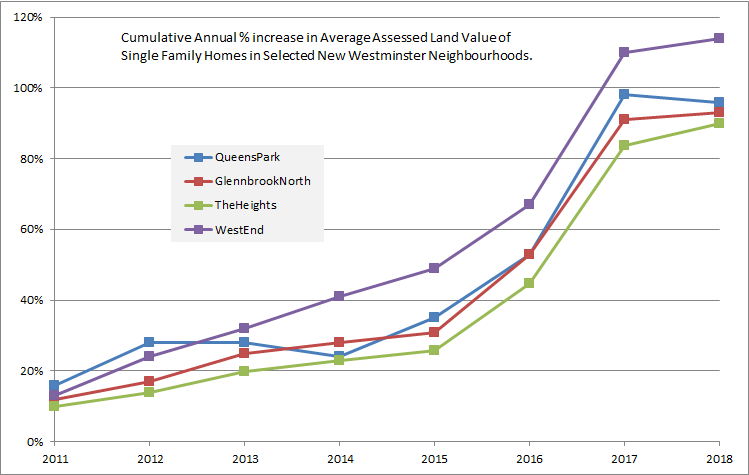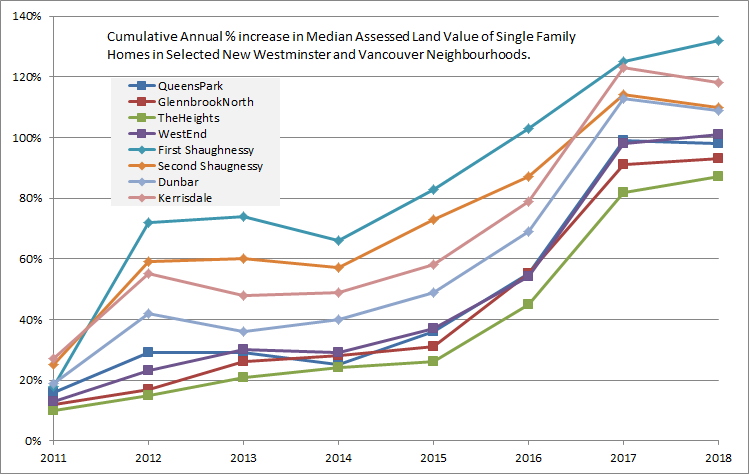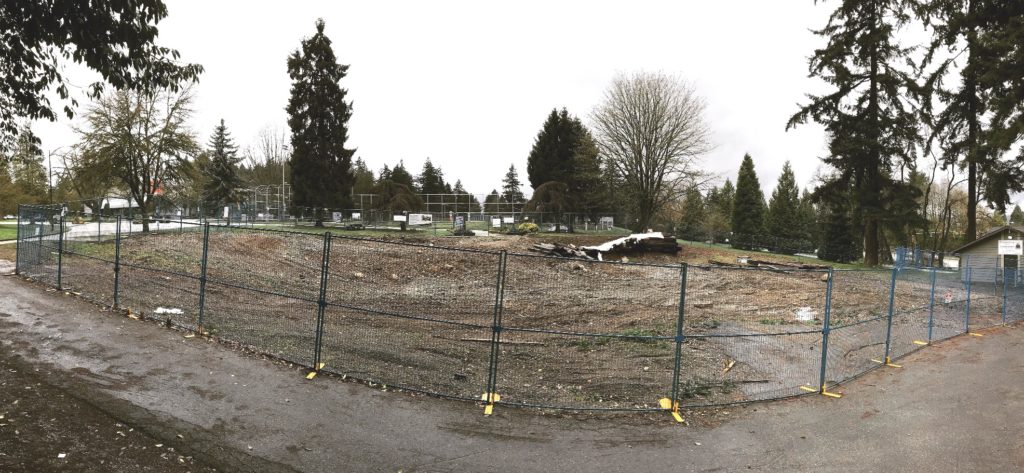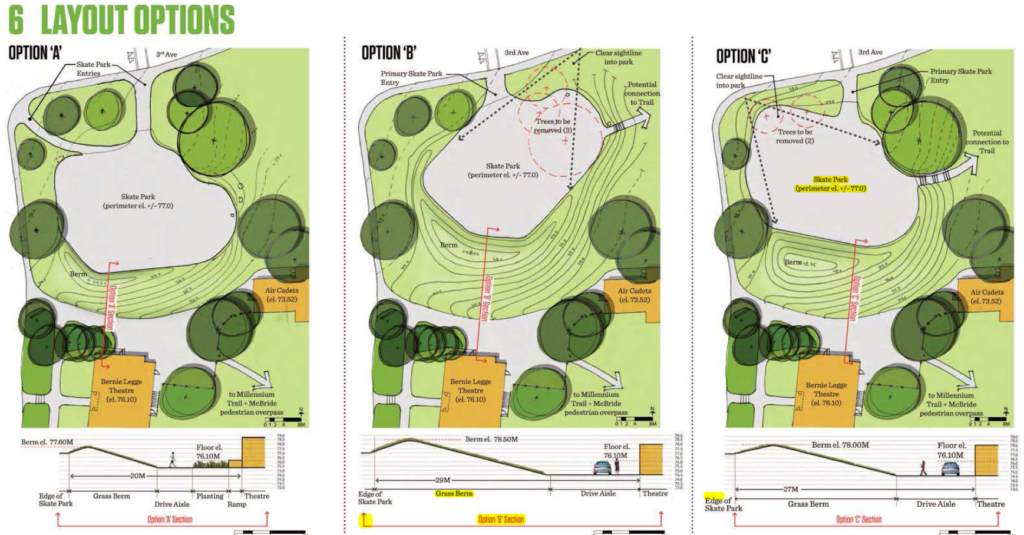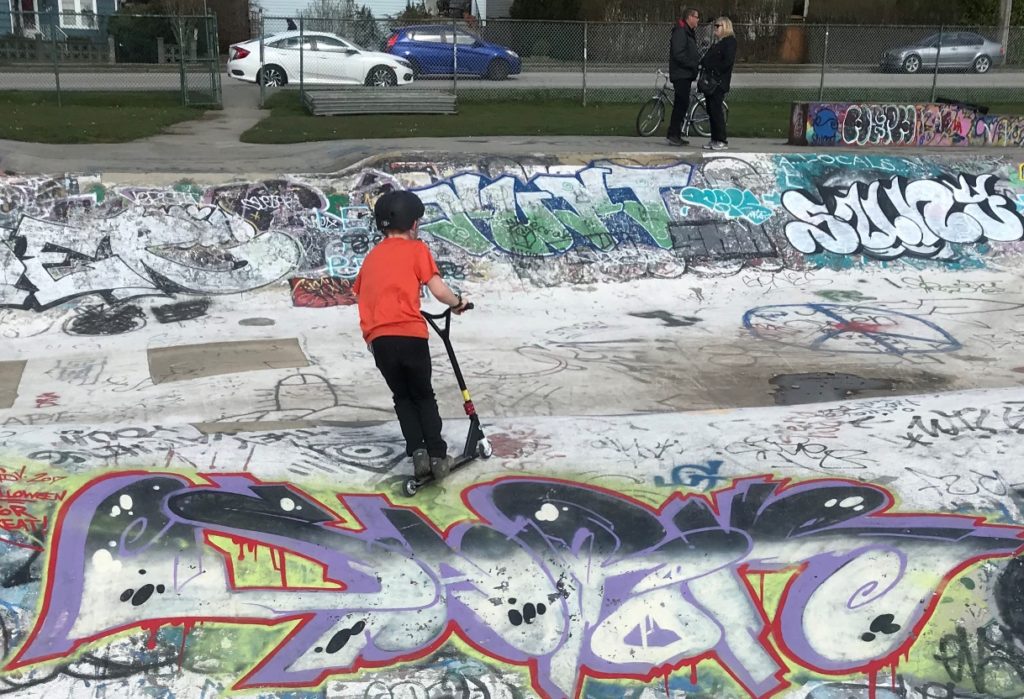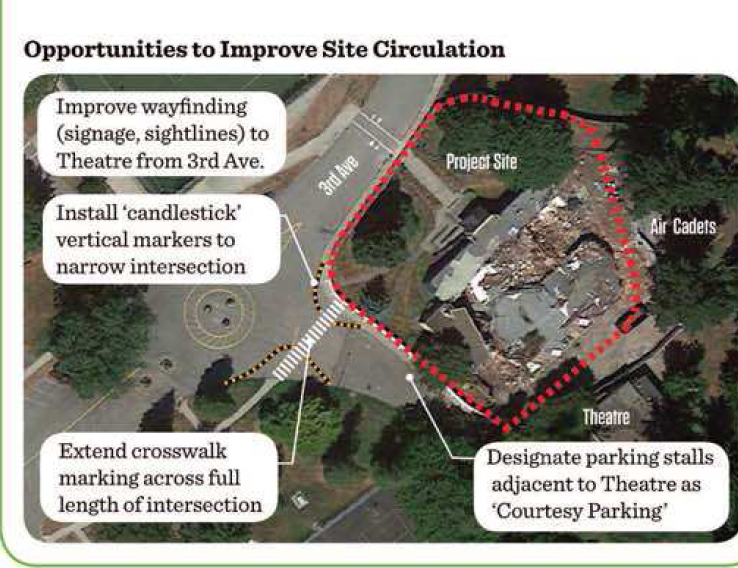It was a long complicated Council Meeting, and not to bury the lede, I’m not going to talk about the Skate Park here, but will save it for a subsequent post. After all this meeting’s lengthy Agenda included starting with the most exciting day of everyone’s Council-watching year:
Parcel Tax Roll
The City’s revenue sources include fees (charging people for services from building permits to swim lessons), property taxes (a tax indexed to the assessed value of a property in the City), and Parcel Taxes (taxes collected based on some other characteristic of the property parcel). Unlike many municipalities, we don’t have a blanket “parcel tax” on all properties, but reserve Parcel Taxes for specific purposes. These are the three Business Improvement Areas (where the City collects the tax, then turns it over to the BIA for them to spend on their programs) and several places where some of the cost of neighbourhood-specific projects are charged to the neighbourhood as a special assessment (such as infilling ditches in Queensborough).
Every year, we have to officially review the roll of properties for which Parcel Taxes are applied, and give those properties an opportunity to appeal that the tax doesn’t apply to them. We then sign the roll to show we have done this. Thrilling stuff.
The Regular Meeting then followed, with the following items Moved on Consent:
Recruitment 2018 Arts Commission Representative on the Public Art Advisory Committee
Our Arts Commission has a representative on the Public Art Advisory Committee. Council approved the appointment of their designated representative.
838 Ewen Avenue (Modular Housing): Official Community Plan Amendment, Rezoning and Development Permit Applications – Preliminary Report and Section 475 and 476 Consultation Report
This parcel of land belongs to the City, and there is a plan to put Provincially-supported modular housing on it as part of our ongoing affordable housing program. To do this, we need to change the Official Community Plan designation for the land, which requires consultation with a wide breadth of parties, including public consultation. This report provides the preliminary project plans and details of the upcoming consultation schedule.
Construction Noise Bylaw: Consideration of Changes to Permitted Hours and Update on Pile Driving Methodology Research – Bylaw for Three Readings
The City has been looking into the issue of construction noise, and particularly the impacts (pun!) of pile driving. This issue really emerged with the early stages of construction of two buildings in downtown last summer. This Bylaw will change the construction hours on weekends, and limit some types of pile driving. There is a great attached report from the Engineer about the benefits and costs of different pile driving techniques. Council moved to give these Bylaws three readings.
520 Carnarvon Street: Heritage Revitalization Agreement and Heritage Designation Bylaws – Consideration of First and Second Readings
The owners of this 1898 house on Carnarvon want to preserve it, and build an extension on the back. This will involve a heritage conservation plan, and some land use changes to bring the commercial/residential mixed use into compliance. The Downtown RA, the Advisory Planning commission, and the community Heritage Commission are all good with the plan. So Council gave it two readings, and it will go to Public Hearing, so I’ll hold my comments until then.
318 Fifth Street: Heritage Revitalization Agreement and Heritage Designation – Consideration of First and Second Readings
This project will bring a largish laneway house to Queens Park, in exchange for Heritage Designation of the main house, and a long-term restoration plan. Council gave this project two readings, and it will go to Public Hearing, so I’ll hold my comments until then.
1084 Tanaka Court: Rezoning and Development Permit for Banquet Hall – Bylaw for First and Second Readings
This project would see a large banquet hall built on an undeveloped piece of commercial property near the Casino in Queensborough. Council gave the proposal First and Second readings, and as it will be coming to Public Hearing, I’ll hold my comments until then.
306 Gilley Street: Heritage Revitalization Agreement and Designation Bylaws – Consideration of First and Second Readings
This HRA and development project would bring some infill density to a lot in the Brow of the Hill, while protecting the heritage house on the same lot. Council gave the proposal First and Second readings, and as it will be coming to Public Hearing, I’ll hold my comments until then.
18. Queen’s Park Heritage Conservation Area: Special Limited Category Expanded Study Update
How do we protect heritage homes, while mitigating the impact houses that may not have real heritage value, and how to tell the difference?
With an HCA the size of Queens Park (the largest in the province, possibly in Canada), there are some properties that may be caught up that probably have limited heritage value and don’t necessarily need protection. I’m not an expert at evaluating Heritage Value (which is why Council shouldn’t be deciding without expert advice), but there are experts who do this exact thing for a living.
Currently, a person with a pre-1940 house in Queens Park can apply to have the protection level for their house reduced (up to an including allowing for its demolition) based on a heritage assessment demonstrating there is no heritage value to be lost. There are some examples of houses built before 1940 that had significant renovations later on and look more like a 70’s house (including 70’s materials) with none of the characteristics of the original pre-war house. In the spirit of the HCA, the owner should be able to demolish this house and replace with a new house that meets the HCA guidelines. Due to the structure of the HCA permitted under the Community Charter, that takes an OCP update, which is a bit of a hassle for a one-off.
To help out property owners caught in the middle here, the City is launching a program to fast-track the assessment of houses where the owners feel they should be reduced in protection, by packaging all of the assessments together and doing a single OCP amendment. This should save the City and the homeowners quite a bit of time and money in the long run. There will be a small charge to the homeowner (approximately 1/3 of what a heritage assessment would cost if they did it alone), but if they opt in, this will be the easiest path to reducing the protection of a house with no heritage value.
This requires a Bylaw, so we asked staff to write it.
41 – 175 Duncan Street: Official Community Plan Amendment and Zoning Amendment for Townhouse and Child Care Development – Bylaws for First and Second Readings
This large townhouse development in Queensborough will include a space for a daycare, and some significant improvements to the waterfront adjacent to Port Royal. The Residents Association has no objections, and the project complies with the FCM Rail Proximity guidelines (as there is a lightly-used Southern Railway line along the south boundary of the property). The Design Panel and Advisory Planning commission are OK with it. It will be going to Public Hearing, so I’ll hold off on my comments until then.
Amendment to Bylaw Notice Enforcement Bylaw No. 7318 as a result of revisions to the Water Shortage Response Bylaw No. 6948, 2004
Our Bylaw Notice Enforcement Bylaw needs to be edited to comply with the new Water Shortage Response Bylaw. Fines aren’t changing, we just need to align the language so the bylaws are enforceable.
Food Truck Vending at Westminster Pier Park
We have not had a huge pick-up on food trucks in the City since we opened up our permitting to allow them to operate. Other than a hugely successful Food Truck Festival, and a few special events, we don’t seem to be in a place where ad-hoc random food truck locations are financially viable for the operators. The trial at the Pier Park didn’t really work out. We still have a policy to allow it in other parts of the City, and will revisit this again in the future, depending on how the trend evolves.
228 – 232 Sixth Street (La Rustica): Rezoning and Development Permit for a Proposed Six Storey Residential Building – Bylaw for First and Second Readings
This proposal would see a 6-story residential building where there is currently an abandoned and boarded-up restaurant space in the Brow of the Hill. The project was approved by the Design Panel and Advisory Planning Commission, after several rounds of redesigns to fit the space and setting a little better. As this will will be going to Public Hearing, I’ll hold off on my comments until then.
406 – 412 East Columbia Street: Rezoning and Development Permit for Proposed Six Storey Mixed Use Development – Bylaw for First and Second Readings
This proposal would see a 6-story mixed-use building on a currently vacant lot in Sapperton. The development is an interesting mix, with commercial on the ground floor, a floor of office space, then 4 stories of residential. The project was approved by the Design Panel and Advisory Planning Commission, after some discussion of the creative design of the living spaces to make them fit with limited footprint and setbacks. As this will be going to Public Hearing, I’ll hold off on my comments until then.
224 Sixth Avenue: Heritage Revitalization Agreement and Heritage Designation – Bylaws for First and Second Readings
This HRA will extend permanent protection and a restoration plan to a heritage house in Queens Park while subdividing the property and infilling with an smaller house on the same rateher wide lot. The Community Heritage Commission and Advisory Planning Commission are OK with the designs. Once again, this will be going to a Public Hearing, so I’ll hold off on my comments until then.
Canada Post Corporation Driver Infractions and Road Misuse
Allegedly, a few Canada Post employees were driving like jerks. The NTAC wants the Mayor to send a letter to Canada Post and ask them to drive better. What the hell, can’t hurt, can it?
The following items are Removed from Consent for discussion:
118 Royal Avenue: Rezoning and Development Permit for Four Unit Rowhouse – Bylaw for First and Second Readings
This project would see 4 rowhomes built where there is currently a single family home on Royal Avenue right next to QayQayt School. This will come to Public Hearing on April 30, so I am once again going to hold off on commenting. And boy I have comments on this one!
Proposed BC Energy Step Code Requirements for New Part 9 Residential Buildings
The City is implementing Step Code standards for our residential housing stock. This is part of a Province-wide program where the building code is creating shifts towards energy performance standards for new buildings through progressive ramping up of standards (“steps”). The City is exercising its option to phase in progressively higher steps. This takes a bit of time, as we will need to train builders on performance-based standards that come with “stepping up”, and our building inspectors to understand how to test and implement these standards. We are one of about 20 local Governments in BC who has taken this route, some slightly more aggressive than New West, most are about where we are. This isn’t free for builders, or the City, but our community will become more efficient, our housing stock more comfortable and our GHG emissions lower through this. I’m happy to support it.
2017 Filming Activity Update
There is a lot of filming in New West, and in 2017, our permitting fees from filming grossed just a little over $1M. This is aside from all of the filming fees collected by local homeowners and businesses, and all of the spin-off economic benefits of a vibrant film industry in our community. This report by our staff Filming coordinator updates where we are in this file.
Mercer Stadium Skatepark Relocation Project
I have a bunch to say about this, as I have received and responded to about 100 e-mail on this issue, and had about a dozen Delegations on the topic, but I’ll save that for a subsequent Blog Post. Short version: I’m not excited about the decision made by Council, or the way we made the decision, but I am cautiously hopeful we can still get this facility built in Queens Park this summer.
Before we got to the Public Delegations and presentations, we went through our regular Bylaws shuffle that was a record length in my time on Council:
Heritage Revitalization Agreement (318 Fifth Street) Bylaw No. 7977, 2018 and
Heritage Designation (318 Fifth Street) Bylaw No. 7978, 2018
As discussed above, this HRA and Laneway House project in Queens Park was given two readings. It will go to Public Hearing on April 30. C’mon out and tell us what you think.
Heritage Revitalization Agreement (224 Sixth Avenue) Bylaw No. 7989, 2018 and
Heritage Designation (224 Sixth Avenue) Bylaw No. 7990, 2018
As discussed above, this HRA and subdivision project in Queens Park was given two readings. It will go to Public Hearing on April 30. You should show up to tell us what you think.
Heritage Revitalization Agreement (520 Carnarvon Street) Bylaw No. 8004, 2018 and
Heritage Designation (520 Carnarvon Street) Bylaw No. 8005, 2018
As discussed above, this HRA that will renovate/expand the building and change the land use in Downtown was given two readings. It will go to Public Hearing on what is starting to look like a busy April 30. It might be worth showing up to tell us what you think.
Heritage Revitalization Agreement (306 Gilley Street) Bylaw No. 8007, 2018 and
Heritage Designation (306 Gilley Street) Bylaw No. 8008, 2018
As discussed above, this HRA with infill housing project in the Brow of the Hill was given two readings. It will go to Public Hearing on April 30. Anyone sensing a trend here?
228 – 232 Sixth Street (La Rustica) Zoning Amendment Bylaw No. 7996, 2018
As discussed above, this development for a 6-story building in the Brow of the Hill was given two readings, and will go to Public Hearing on April 30. That is going to be a busy evening, but you should show up if you have opinions or concerns.
1084 and 1130 Tanaka Court and a portion of the existing road right of way Zoning Amendment Bylaw No. 8011, 2018
As discussed above, this proposal to build a large banquet hall on an undeveloped piece of commercial land near the Casino was given three readings. It will be part of this remarkably diverse and exciting Public Hearing on April 30. There must be at least one of these projects you have an opinion for or against!
118 Royal Avenue Zoning Amendment Bylaw No. 7954, 2018
As discussed above, this project would build 4 row homes on Royal Ave next to QayQayt school. It was given two readings, and will go to Public Hearing on April 30. Seriously, everyone who is anyone is going to be there!
175 Duncan Street Official Community Plan Amendment Bylaw No. 7982, 2018 and
41 and 175 Duncan Street Zoning Amendment Bylaw No. 7983, 2018
As discussed above, this larger townhouse project in Queensborough was given two readings, and will go to Public Hearing on April 30. You really think we weren’t going to include a little Q’boro in the Mother of All Public Hearings?
406 – 412 East Columbia Street Zoning Amendment Bylaw No. 7995, 2018
As discussed above, this mixed-use project on an empty lot in downtown Sapperton was given two readings, and will be included in the Public Hearing on April 30. Seriously, this has to be some kind of record.
Construction Noise Bylaw Amendment Bylaw No. 8013, 2018
This Bylaw that changes construction hours in the City was given three readings. No Public Hearing for this one! But there will be an Opportunity to be Heard on May 7. C’mon out and let us know what you think.
Development Services Fees and Rates Amendment Bylaw No. 8009, 2018
This Bylaw that allows us to charge a fee for opting into the collective Queens Park HCA Special Limited Category Study (see above) was given three readings. No Public Hearing needed for this one, either!
Bylaw Notice Enforcement Housekeeping Amendment Bylaw No. 8012, 2018
This Bylaw that aligns our Notice Enforcement Bylaw with the new water restriction bylaw was given three readings. I’m going to go ahead and assume you have no opinions on this.
Water Shortage Response Amendment Bylaw No. 7988, 2018 (Revisions to the Water Shortage Response Plan)
This Bylaw that aligns our Water Shortage Response Plan with the regional plan from Metro Vancouver was Adopted by Council. It’s the law of the land, schedule your sprinkling accordingly.
Electrical Utility Amendment Bylaw No. 7998, 2018
This Bylaw that adjusts our Electrical Utility rates to match the 3% increase in BC Hydro rates was adopted by Council. It is the law of the land, please adjust your light bulbs accordingly.
Then we had presentations, public delegations and an extended conversation about locating a Skate Park in Queens Park. I’ll report on that some time in the next few days. Same Pat-time, same Pat-channel!
